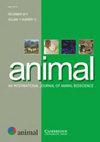How increased heifer growth rate and reduced dairy cow replacement rate can improve farm economy and reduce greenhouse gas emissions - a win to win situation?
Abstract
Rearing of replacement heifers makes up a significant part of the total costs in dairy farming. Nevertheless, the average age at first calving for dairy heifers still stays well above 2 years in many countries. This study examined the economic and environmental impacts of increased heifer growth rates and reduced replacement rates on Norwegian dairy farms. The current average growth rate in Norway (baseline scenario) was compared to an accelerated growth rate scenario. Within each of the two growth rate scenarios, we compared three different cow replacement rates. A farm account survey dataset containing physical and economic data on 311 Norwegian farms was clustered into three farm groups: small, medium, and large. To model economic consequences, we used the whole-farm linear programming model ScotFarm. A life cycle analysis model was used to model the environmental impacts of the baseline scenario and an accelerated growth rate scenario on the three farm groups. Accelerated heifer growth rate had a positive effect (14–28%) on farm annual gross margin depending on farm size. While accelerated growth rate resulted in only minor reductions in total emissions at farm level compared to the baseline scenario, reduced replacement rate lowered total farm level emissions by up to 8%, and emissions per unit of output by up to 6%. We conclude that an accelerated heifer growth rate scenario could potentially increase farm gross margin by some 14–28% compared with a baseline growth rate scenario. Reducing the replacement rate would be more efficient to reduce farm−level greenhouse gas emissions.

 求助内容:
求助内容: 应助结果提醒方式:
应助结果提醒方式:


